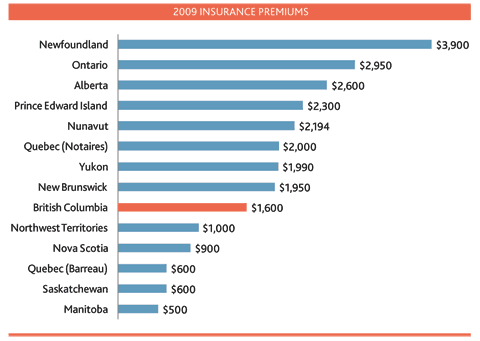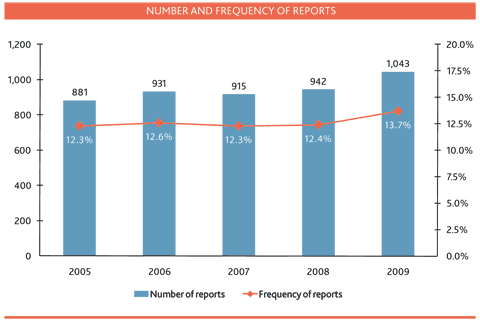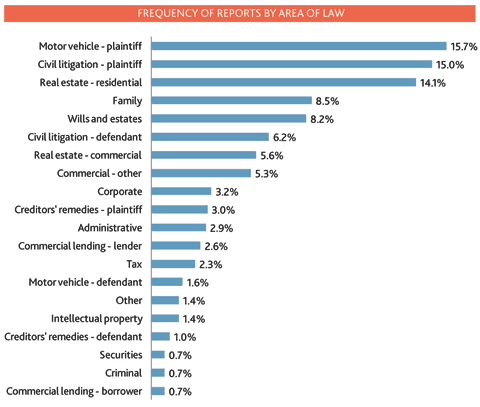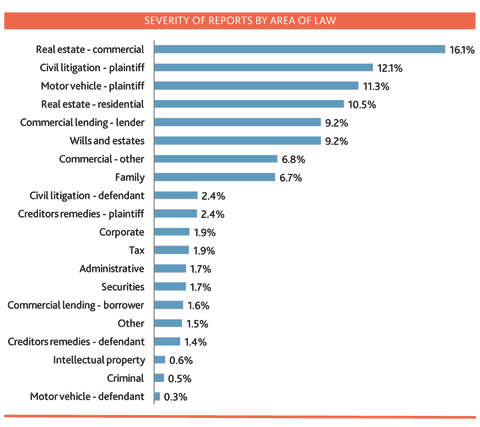The Lawyers Insurance Fund manages the Law Society’s insurance program for BC lawyers. The program provides insurance for negligence (Part A of the policy) and theft (Part B of the policy).
Our mission
In managing the program, we are guided by our mission statement:
The Lawyers Insurance Fund protects the profession and the public from the risks associated with the practice of law by providing high quality professional liability and defalcation insurance. We draw on our knowledge and skill as experienced lawyers to deliver professional and cost-effective claims and risk management, and underwriting services. Through hard work and best practices, we ensure the continuing excellence of the insurance program and maintain the confidence of the profession.
Insurance assessment
In any lawyers’ liability insurance program, the aftershocks of a recession can continue to reverberate for several years. The numbers of claims increase. Costs tend to increase, as well, particularly in reports arising out of commercial areas of practice. Although the ultimate impact on claims of this latest economic downturn remains to be seen, the Fund’s investments have already been negatively affected, and are not generating the level of surplus income that in past years helped offset the insurance fee. Based on these factors and appreciating that a small early adjustment in the fee may avoid a more dramatic increase later, the Benchers approved a modest increase for the first time in 17 years of $200, and set the 2010 assessment at $1,600. In fact, lawyers in all Canadian jurisdictions (except Newfoundland) are paying more this year for insurance. However, our fee still remains low, particularly in comparison with Ontario and Alberta, two other larger programs (see chart below). The cost becomes even more attractive given that our policy is unique in insuring both negligence and theft, through Part B trust protection coverage. No separate fee will be charged or assessment levied for Part B coverage in 2010.

Compulsory policy wording
A consolidated policy for 2010 was issued, introducing changes as follows:
Part A (insurance for negligence)
Several changes are made to clarify the policy’s intent.
Definitions
Coverage is generally available to lawyers acting as executors or in similar fiduciary capacities, provided that the lawyer maintains a law practice and is asked to act because he or she is a lawyer (not, for example, because of a familial relationship). Paragraph (d) of the definition of “professional services” required that these services be connected with and incidental to the lawyer’s “profession as a lawyer.” That definition is changed by replacing the words “profession as a lawyer” with “practice of law,” a phrase that better clarifies the relationship the policy intends to capture.
Insuring Agreements
For the most part, professional liability claims fall within the Policy’s broad coverage, triggering the duties to defend and indemnify. Sometimes, however, litigation involves both covered and uncovered allegations, or claims. For instance, a lawyer providing legal services to a company and sitting as a director may be sued both as a lawyer (covered) and as a director (not covered). Or, a lawyer may be sued both for damages for negligence (covered) as well as for a return of fees (not covered). In these situations, the lawyer bears some responsibility for the cost of the defence because of the uncovered aspects of the claim. Insuring Agreement A 2 is revised to reflect that responsibility more clearly. Provisions requiring the lawyer to contribute to the costs at the start of the defence, if requested, and setting out mechanisms for determining the final allocation of defence costs, are also included. Of course, the lawyer is also responsible for any part of a judgment or settlement that falls outside cover.
Conditions
Condition 3 deals with the insured’s obligation to reimburse us in certain circumstances. Conditions 3.2 and 3.3 are revised slightly to include the possibility of partial reimbursement in light of the revisions to Insuring Agreement A 2.
Condition 4.1 sets out the requirement of timely reporting by a lawyer of a claim or potential claim, critical for cost-effective management of the program to the benefit of all insured lawyers. Early reporting allows us to fix a problem or take other steps to minimize the financial consequences of a mistake. The duty to report now requires lawyers to give written notice “immediately,” rather than “as soon as practicable.”
The Law Society has a protocol that maintains the confidentiality of claims information. Some exceptions, such as the Law Society’s financial auditors, are identified. As Condition 5.4 had repeated those exceptions, the Condition is revised to simply refer to the protocol.
The policy’s limits are unchanged: each insured lawyer enjoys $1 million of coverage for all claims arising out of a single error or a series of related errors, to an annual maximum of $2 million for all claims arising out of separate errors reported during the year. Both limits are eroded by defence costs. The deductible also remains unchanged: $5,000 for a paid claim, increasing to $10,000 for each subsequent paid claim reported within three years.
Part B (insurance for theft)
Two changes were made to the Part B coverage for 2010.
Exclusion 17 of the policy excludes coverage for claims arising from or in connection with investments, including fraudulent investment schemes. In Ponzi schemes, the returns received by participants are paid using either their own funds, or funds obtained by new participants in the scheme. The exclusion is revised to clarify that Part B does not apply in any circumstances to such claims, even if characterized as something other than an investment, such as a loan.
Under the National Mobility Agreement, lawyers are permitted to practise the law of or in a reciprocating jurisdiction temporarily (up to 100 days a year), without becoming a member of that jurisdiction. Most Canadian jurisdictions reciprocate, and have now agreed that if a lawyer steals while in one, the “home” law society will pay up to $250,000 per claim to a maximum of $2 million per lawyer, subject to any ultimate fund limits (for BC, this is the profession-wide aggregate of $17.5 million). These limits are incorporated into the policy through revisions to the Declarations and to the limits of liability for Part B in the Conditions.
The policy continues to provide a profession-wide aggregate limit of $17.5 million for Law Society members, and a per claim limit of $300,000 (except for inter-jurisdictional practice as noted). Lawyers are obliged to reimburse the insurer in full for paid claims.
A copy of the 2010 consolidated policy is included with this mailing. Copies of other policies and endorsements issued since 1999 are available in the Insurance section of the Law Society’s website (lawsociety.bc.ca).
A review of claim and potential claim reports
Part A (insurance for negligence)

The chart above shows the number of reports and their frequency (reports divided by insured lawyers) over the past five years. Reports include both claims and potential claims. The numbers are consistent with our previous experience of increased claims activity following a recession.
More information about the specific claims experience in 2009 by area of law is provided in the following charts. The first shows the areas of practice giving rise to the greatest — and least — number of reports. Civil litigation – plaintiff and Motor vehicle – plaintiff continue to account for almost a third of all reports, likely because of the higher exposure of practitioners in these areas to missing a deadline and claims of “settler’s remorse”. The second shows the areas of practice according to the actual or expected cost of reports. Due to a weakened economy, the conveyancing and commercial areas of law account for over half of all dollars spent or reserved.


Part B (insurance for theft)
Since this coverage was introduced in May 2004, there have been 120 reports of claims and potential claims involving 51 lawyers. However, in many of these reports the claim is without merit, and our claims experience continues to demonstrate that only a very small number of lawyers are involved in misappropriations.
In 2009 nine claims were paid on behalf of five different lawyers, totalling $23,847. Details of these claims follow:
- Two claims totalling $3,529 were paid on behalf of a lawyer. In both, the lawyer acted on behalf of purchasers, and kept funds to which his clients were entitled.
- Two claims totalling $11,640 were paid on behalf of a lawyer. In the first, the lawyer received proceeds from the sale of a matrimonial home and was to use a portion of those funds to pay an outstanding loan. The lawyer kept the funds instead. In the second, the lawyer received funds from a client to pay Property Transfer Tax on a purchase. The lawyer’s cheque, submitted with the transfer, was returned “not sufficient funds” and the transfer was rejected. The lawyer had taken the client’s funds.
- Two claims totalling $2,615 were paid on behalf of a lawyer, although the lawyer subsequently reimbursed the Law Society for both. In the first, the lawyer was retained to act for a client seeking a divorce. The lawyer paid herself fees for obtaining the divorce out of funds held in trust for the client. In fact, the divorce was never obtained. In the second, the lawyer acted for a purchaser of a condominium, and deducted her fees from mortgage proceeds she received. Included in the fee was an amount for submitting GST rebate applications, work the lawyer never actually did.
- A payment of $4,213 was made on behalf of a lawyer who received funds from a client to pay Property Transfer Tax on a transfer of property into joint tenancy. The transfer was rejected and the tax payment refunded. The lawyer paid the funds into his general account, apparently by mistake, but then kept the funds.
- Two claims totalling $1,850 were paid on behalf of a lawyer. In both, the lawyer accepted and kept a retainer to process an immigration application, but did not provide services to justify the amount kept.
None of the lawyers involved remain as members of the Law Society, and all are obliged to reimburse the Law Society for the amounts paid on their behalf.
In 2009, just under $25,000 was recovered in relation to payments made under Part B. As noted, two claims totalling $2,615 were repaid by the lawyer on whose behalf the payments were made. Another lawyer for whom a payment of $2,386 was made in 2008 repaid $1,600 in 2009 pursuant to a monthly repayment plan. An additional $20,705 was recovered from funds held on behalf of two lawyers for whom payments totalling $35,324 were made. We also sued two former members for amounts paid on their behalf under Part B, although we have not yet made any recoveries.
Seven claims were withdrawn or abandoned by claimants, and three matters reported as potential claims did not develop into claims. Two claims were not pursued because the client was paid directly by the lawyer. Three claims did not fall within coverage for Part B, as they did not involve misappropriations. In the remaining reports, the claimants are not actively pursuing a Part B claim, or we are not yet in a position to determine if the claim is properly payable or, in some instances, to whom or how much.
Multi-disciplinary partnerships and Quebec mobility — the insurance piece
Two initiatives recently approved by the Benchers will result in further changes to the insurance policy and program in 2010.
Multi-disciplinary partnerships
In December, the Benchers passed amendments to the Law Society Rules and the Professional Conduct Handbook that will permit lawyers to form partnerships with non-lawyers in limited circumstances. To protect the public, non-lawyer partners are required to buy both the compulsory policy and any additional limits of coverage secured by lawyers in the partnership.
Quebec Mobility Agreement authorized
In January, the Benchers approved an agreement proposed by the Federation of Law Societies to establish reciprocal mobility between Canadian common law jurisdictions and the Barreau du Quebec. Pursuant to the agreement, BC will insure its members for their practice in Quebec.
Neither initiative is expected to create material risk to the program. Both will involve some minor revisions to policy wording later this year by endorsement.
The Lawyers Insurance Fund: Discover us
“The Lawyers Insurance Fund has attained a level of quality and consistency that should be the envy of the insurance industry.” – Crawford Adjusters Canada claims audit, 2003
“The Lawyers Insurance Fund is in a class of its own among Bar mutual organizations ... the level of professionalism and sense of mission achieved by staff (LIF claims counsel) remains unique.” – Nicholl Paskell-Mede claims audit, 2006
We value our position as one of the premier lawyers’ insurance programs in the world. At the heart of that reputation is the attention and expertise we bring to each specific report and the excellent service that our defence counsel partners provide. The quality of our program is also a reflection of the valuable resources we offer the lawyers we serve.
The program and the insurance policies
We provide a tremendous amount of information about our program and insurance policies, including:
- Reporting guidelines explaining exactly what information is needed to report a matter;
- Complete contact information for LIF claims counsel, including their areas of expertise;
- Details of coverage under the policies;
- Yearly reports on changes to policy wording, our claims experience and insurance issues;
- Summaries of Law Society initiatives, such as national mobility and no-cost pro bono insurance that LIF has developed or supported.
LIF online
To find information provided by the Lawyers Insurance Fund, visit LIF’s section of the Law Society’s website. Go to lawsociety.bc.ca and select “Regulation and Insurance”, “Insurance” and:
Overview – for program information and the insurance policies;
Risk Management – for risk management and fraud prevention materials.
Risk management
Presentations
LIF claims counsel deliver risk management advice to the profession at venues ranging from courses offered by the Continuing Legal Education Society to section meetings of the Canadian Bar Association and sessions held in-house by law firms. In just the past three years, LIF lawyers have participated in close to 40 presentations. Firms interested in this are invited to contact the Lawyers Insurance Fund for more information.
Broadcast emails and publications
Through email, we are able to alert the profession to critical issues that present immediate risk to lawyers. In order to receive these urgent notices, it’s important that the Law Society has your current email address and that you advise our Member Services department (memberinfo@lsbc.org) of any changes in your contact information.
Insurance Issues: Risk Management draws on the Fund’s claims experience to offer advice on practices that present risks to lawyers. Recent issues include:
Email: Preventing a mailstrom – provides examples of the ways in which a lawyer’s use of email has resulted in a report to us, and offers tips to help other lawyers avoid similar mistakes.
Hard Times: Managing risk in a troubled economy – highlights the particular risks created for lawyers in an economic downturn, and offers suggestions to help avoid claims.
Mobility: Managing the risk – learn about the unique risks you face when practising in another jurisdiction, before you set out.
Fraud prevention
Fraudulent real estate and investment schemes
The risk of fraud arises primarily in two areas: real estate and investment schemes. In real estate, the frauds perpetrated are value frauds (inflating the property price for a larger loan) and identity frauds (impersonating an owner to transfer or mortgage a property). In investment schemes, unscrupulous promoters ask lawyers to allow them to deposit funds in their trust accounts from investors who have been promised spectacular profits. Perpetrators of these scams use a lawyer’s trust account and insurance coverage to add credibility to a fraudulent enterprise.
Fraudulent certified cheque scams
Scams such as these continue to plague lawyers. As new scams come to light, the Law Society alerts lawyers through Notices to the Profession and the “Practice Watch” column in the Benchers’ Bulletin.
Coverage enquiries and advance rulings
In a service unique to BC lawyers, LIF staff will answer questions about coverage under the policy in the absence of a claim or potential claim. Any lawyer who wants to know in advance about coverage for mistakes that may arise out of a certain activity or practice is invited to contact one of the “advance ruling advisors”: Surindar Nijjar at 604-605-5314 (snijjar@lif.ca), Kate McLean at 604-605-5377 (kmclean@lsbc.org) or Margrett George at 604-443-5761 (mgeorge@lsbc.org)
LIF’s website also answers a number of frequently asked questions about coverage, and includes an explanation of the policy’s business and benefit exclusion. A recently added FAQ answers the question: Am I eligible for the part-time discount? The answer provides detailed information about the discount, including a list of activities that must be included by lawyers when determining eligibility.
2010 and beyond
The impact of the economic recession on claims may well continue, with increases in both frequency and severity. Cost-effective claims management by LIF and the modest fee adjustment will offset to a degree the expected increased claims activity. However, proactive risk management by lawyers, implementing a careful and systematic approach into daily practice, remains the most effective means of ensuring that the program’s stability continues.